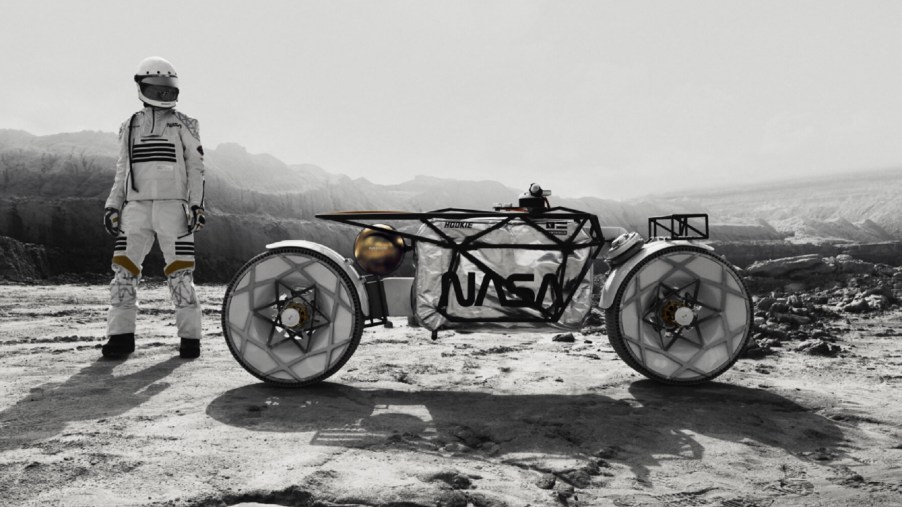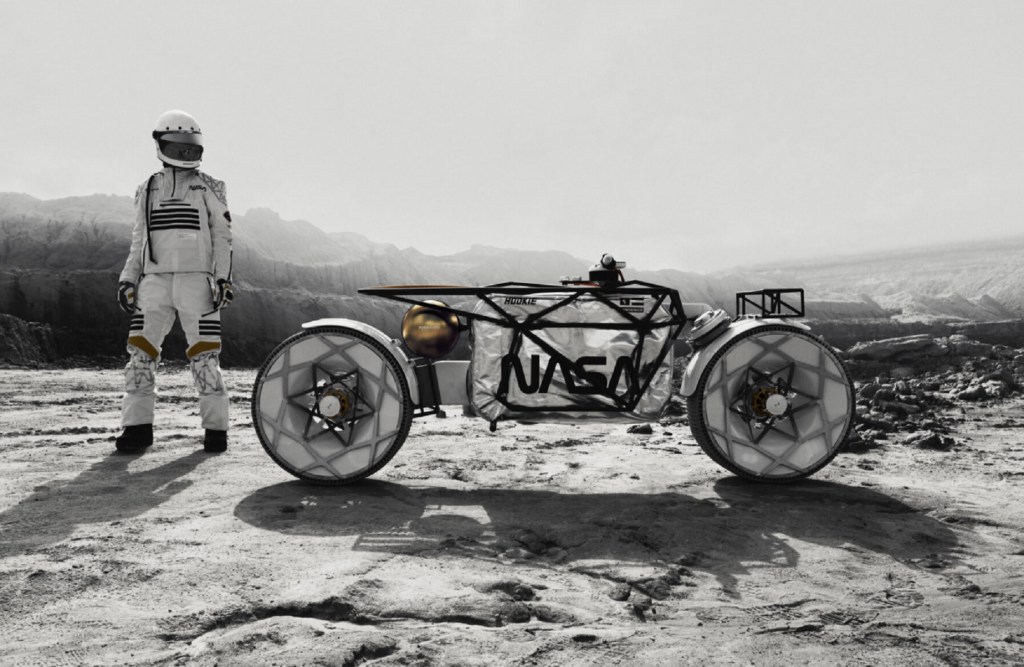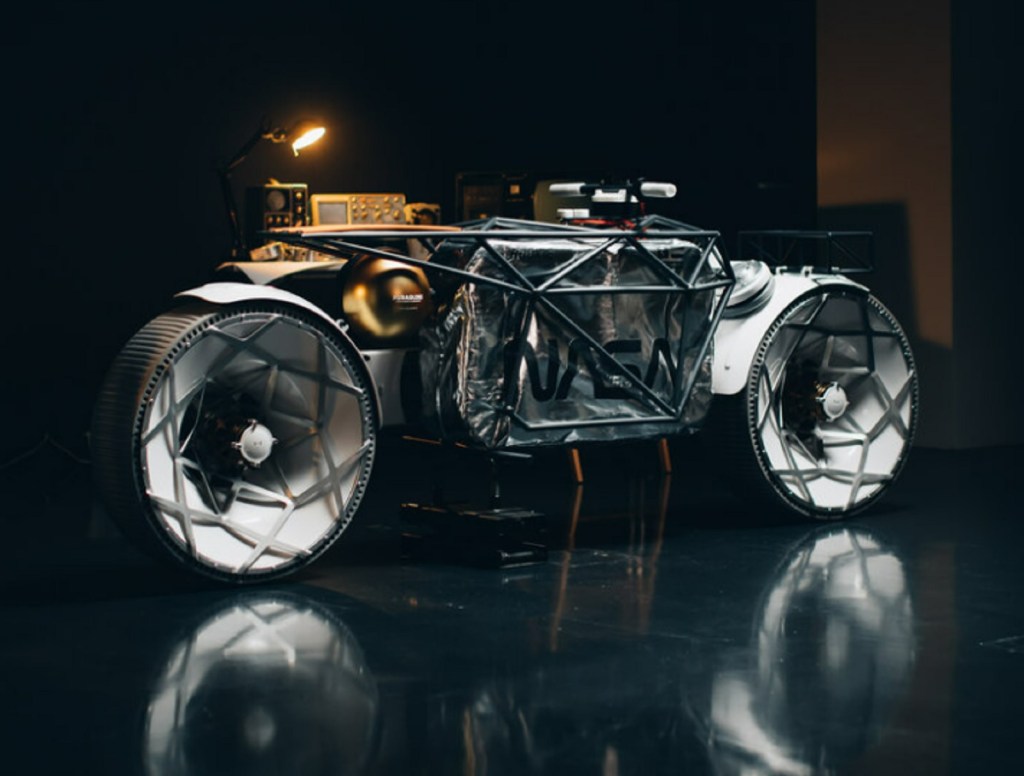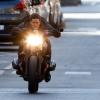
Forget the Moon Rover, Astronauts Need Hookie Co.’s Motorcycle
Whether you call it a moon buggy, moon rover, or by its technical name, the Lunar Roving Vehicle, the four-wheeled machine is one of the most iconic vehicles in history. And, so far, it’s the closest thing to a car that’s explored space to an extended degree. No, that Tesla Roadster in low orbit doesn’t count. However, that hasn’t stopped designers and engineers from thinking about other wheeled ways to see the Moon. And in Hookie Co.’s mind, why use a moon rover when you can ride a moon motorcycle?
German shop Hookie Co. is turning a Russian’s lunar motorcycle concept into a real machine

Dresden, Germany-based Hookie Co. has built up a solid resume of custom motorcycles since it opened in 2015. It’s even developed bolt-on kits based on past builds, including café racer and scrambler/flat-tracker kits for the BMW R nineT. Hookie Co.’s latest project, though, is a bit more, shall we say, nebulous: bringing Russian designer Andrew Fabishevskiy’s lunar motorcycle vision to life.
While the idea of riding a motorcycle on the moon seems odd, it has genuine historical precedence. Before it settled on the original moon rover design, NASA considered sending up an electric dirt bike, The Drive explains. True, when NASA reached out in 2020 for help with the next-gen moon rover, it reached out to automakers like GM. But theoretically, it could’ve just as easily tried talking to motorcycle OEMs.
It’s unclear if Fabishevskiy knew about NASA’s prototype dirt bike before he designed his lunar-exploration motorcycle. Regardless, although he didn’t get the bid, Fabishevskiy posted his digital renderings online. And when Hookie Co.’s founder Nico Müller saw them, he “’was hooked immediately,’” Bike Exif reports.
So, after some back-and-forth, the German shop got permission to make the concept bike a reality. And now, after about a year’s worth of work, it’s finally ready to ride.
First, Hookie Co. gave Fabishevskiy’s concept bike a name: Tardigrade. It’s the name of a microscopic organism that’s also called a ‘water bear,’ and it’s an incredibly hardy little beast. Tardigrades can survive radiation, dehydration, extreme pressure, and temperatures below -300° F and above 300° F. Given where this electric motorcycle is supposed to go, the name seems appropriate.
The Hookie Co. Tardigrade has all the right stuff to be a space motorcycle

| Spec | Hookie Co. Tardigrade |
| Length | 102.4″ |
| Height | 35.4″ |
| Usable battery capacity | 2.5 kWh (based on build images) |
| Claimed range | 68 miles |
| Top speed | 9 mph |
| Weight | 295 lbs |
And yes, the Hookie Co. Tardigrade is an electric motorcycle, just like NASA’s original concept. The German shop previously created two custom motorcycles based on the Cake Ösa+ and Ösa Lite. And to keep the partnership going, the shop incorporated a Cake powertrain and wheel hubs into the Tardigrade.
It’s unclear how much power the Hookie Co. Tardigrade makes, though based on the Ösa lineup’s specs, it’s likely 5-13 hp. However, for safety’s sake, the two-wheeled moon rover alternative is limited to 9 mph. But there’s an upside: more range. The Ösa Lite has more range than the Ösa+, but it still maxes out at 57 miles on a charge. And that’s especially impressive considering that the Tardigrade weighs about 100 pounds more than either Cake bike. Though admittedly, weight is less of an issue in Moon gravity.
But while the Tardigrade uses some Cake components, Hookie Co. made most of the bike itself. The electric moon motorcycle has a custom aluminum frame, swingarm, and fork. Plus, it has multiple 3D-printed body components, including the handlebar mounting unit and wheel caps. And those fancy wheels are 3D-printed, too, albeit out of aluminum.
However, in keeping with the Tardigrade’s mission, it doesn’t have conventional tires. Instead, it rides on custom airless tires made of Kevlar. The motorcycle’s protective powertrain cover uses Kevlar, too, both for physical protection and heat resistance. And to guard against electronic-damaging UV radiation, the cover has an aluminum coating.
Speaking of electronics, the Hookie Co. Tardigrade’s handlebars aren’t physically connected to its fork. This motorcycle has fully electronic steering that feeds inputs to an Arduino controller hooked up to a servo, Bike Exif explains. When the rider turns the handlebars, the servo turns the fork via belt drive.
You’ll be able to see the moon bike for yourself soon
Although Hookie Co. hasn’t performed human testing yet, the Tardigrade isn’t just a static showpiece. This electric motorcycle really runs, and the shop plans on fully testing it soon.
But before that happens, the Tardigrade is going on tour. It’s currently on display at the Petersen Automotive Museum in Los Angeles, California as part of the ADV: Overland exhibit. The exhibit runs through March 2022, so Hookie Co. won’t be testing its build anytime soon.
However, maybe some NASA employee will stroll through and get inspired to give the new moon rover a motorcycle companion.
Follow more updates from MotorBiscuit on our Facebook page.


